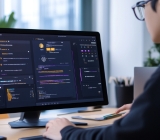From Prototype to Launch! A Comprehensive Guide to the APP Release Process
APPs have become essential tools for enterprises to expand their businesses and serve users. For entrepreneurs, successfully launching an APP is a crucial step towards achieving their business goals. However, the APP release process is complex and involves multiple stages. Any issue in any stage may lead to a failed or delayed release. This article will provide a detailed introduction to the entire process of an APP from prototype to launch, and highlight the potential pitfalls, offering professional guidance to entrepreneurs.
I. Preparatory Stage
(1) Defining the APP Type and Objectives
The type of an APP determines its functional requirements and market positioning. Before development, entrepreneurs must clearly define the core functions of the APP and its target user group. For example, the core functions of a social APP may include user registration, chatting, sharing, etc., while a utility APP focuses on providing specific practical functions, such as bookkeeping and file processing. In addition to entertainment functions, gaming APPs also need to meet strict approval requirements for game licenses.
For different user groups, the design and functions of the APP should also vary. For young users, a simple and stylish interface design and rich social sharing functions are often more attractive; for business people, professional data statistical analysis, multi-language support, and efficient operation experience are crucial.
(2) Preparing Qualifications
Preparing qualifications is an important part before an APP is launched. Different types of APPs require different qualifications. Here are some common qualifications and key points for their application:
- Software Copyright (Soft Copy): The software copyright is an important certificate for protecting the intellectual property of an APP. To apply for a soft copy, you need to log in to the official website of the China National Copyright Administration, fill out the application form, and submit the source code (not less than 1000 lines). The processing fee is 250 yuan per piece, and it usually takes 3 to 6 months to obtain the certificate. During the application process, if the APP name has already been occupied, you can rename it in the form of "APP name + function" to ensure a successful application. At the same time, make sure to submit the complete source code; otherwise, the application will be rejected.
- ICP Filing: ICP filing is a necessary condition for the launch of websites and APPs. Individual developers need to be affiliated with a company for filing, and the cost is about 500 to 1000 yuan per year; enterprise developers need to prepare materials such as a business license, the legal representative's ID card, and the domain name. It should be noted that an APP without ICP filing cannot be launched on the shelves, so make sure to complete the filing procedures in advance.
- Network Culture Business License (Wen Wang Wen Certificate): For APPs with functions such as live streaming, dating, and paid memberships, the Wen Wang Wen certificate is essential. It is difficult to obtain this certificate and requires materials such as the company's articles of association and the server hosting contract. The cost is about 30,000 to 50,000 yuan, and the processing period is 3 to 6 months. Since the application process is relatively complicated, it is recommended to plan in advance and seek the assistance of professional institutions.
- Security Assessment Report: Social and dating APPs need to provide a security assessment report to ensure the security of user information. The security assessment report is usually issued by a third-party institution, such as the China Certification Center for Information Security. When entrusting a third-party institution for a security assessment, choose an institution with qualifications and rich experience to ensure the accuracy and effectiveness of the assessment results.
- Privacy Policy and User Agreement: The privacy policy and user agreement are important documents for protecting users' rights and interests and are also necessary conditions for APPs to be launched on the shelves. Entrepreneurs can refer to the templates provided by platforms such as Tencent Cloud and Alibaba Cloud and customize them according to the actual situation of the APP. When writing the privacy policy and user agreement, clearly define key information such as the scope of data collection, storage period, and usage method to ensure compliance with laws and regulations.
II. Development and Testing Stage
(1) Code Development and UI Optimization
- Technology Selection: Choosing the right technology framework is crucial for APP development. Currently, cross-platform frameworks are widely used in APP development. Here are the characteristics of several common frameworks:
- Flutter: Based on the Dart language, it has excellent performance and is suitable for developing utility APPs. Flutter can quickly build high-performance and high-fidelity user interfaces and achieve a near-native experience on both iOS and Android platforms. Its hot reload function greatly improves development efficiency, allowing developers to view the effects of code changes in real-time.
- React Native: Suitable for the development of social APPs, it builds mobile applications through JavaScript and React, and the code can be reused, improving development efficiency. However, additional processing is required when interacting with native modules to ensure the stability and performance of the application.
- uni-app: A framework for developing all front-end applications using Vue.js, which can achieve the release of one set of code on multiple platforms, including iOS, Android, Web, and various mini-programs and quick apps. uni-app has a rich component library and ecosystem and is suitable for the development of APPs with relatively simple business logic, such as information and e-commerce APPs. However, when dealing with highly customized functions or functions with extremely high performance requirements, it may be necessary to optimize in combination with native development.
- In addition, the Kivy framework in Python has relatively poor performance and is only suitable for simple utility APPs. Careful consideration is required when choosing it.
- Function Implementation Details: During the function implementation process, it is necessary to ensure that the APP has some basic functions, such as user registration/logout, privacy policy pop-up windows, data export (CSV/Excel), etc. Among them, the user logout function is one of the important indicators for APP review. If this function is missing, the APP will be directly rejected. Therefore, during the development process, make sure to include these necessary functions in the development plan and ensure their normal operation.
(2) Testing and Optimization
- Function Testing: Function testing is a key link to ensure the normal operation of all functions of the APP. Testers should formulate detailed test cases according to the functional requirements of the APP and conduct a comprehensive test of all functions of the APP. During the testing process, focus on the stability and accuracy of core functions such as user registration, login, data submission, and query, and promptly discover and fix potential problems.
- Compatibility Testing: Due to the large number of mobile device brands and various operating system versions, the compatibility issue of APPs cannot be ignored. Compatibility testing should cover mainstream mobile devices and operating system versions to ensure that the APP can be displayed and run normally on different devices. At the same time, pay attention to the display effect of the APP under different resolutions and screen sizes to provide users with a consistent experience.
- Performance Testing: Performance testing mainly includes testing indicators such as the response time, throughput, and memory usage of the APP. Through performance testing, the performance bottlenecks of the APP under high concurrency can be found, and timely optimization can be carried out. Optimization measures include code optimization, database optimization, server configuration adjustment, etc., to ensure that the APP maintains good performance in various situations.
- Security Testing: Security testing is an important means to ensure the security of APP user information. Security testing should include vulnerability scanning, penetration testing, data encryption testing, etc., to ensure that there are no security vulnerabilities in the APP and that user data is effectively protected. During the testing process, focus on issues such as the data transmission security, storage security, and user privacy protection of the APP, and take timely measures to fix them.
III. Launch and Promotion Stage
(1) APP Shelving
- Application Store Selection: Currently, the mainstream application stores include the Apple App Store and major Android application stores. Entrepreneurs should choose the appropriate application store for shelving according to the target user group and market positioning of the APP. At the same time, understand the shelving rules and review requirements of each application store to ensure that the APP can pass the review smoothly.
- Shelving Preparation: Before the APP is shelved, relevant materials such as the APP icon, screenshots, description, and keywords need to be prepared. These materials will directly affect the display effect and search ranking of the APP in the application store, so they should be carefully designed and written. At the same time, make sure that the version number, package name, and other information of the APP are accurate to avoid shelving failure due to incorrect information.
- Review and Shelving: After submitting the APP shelving application, the application store will review the APP. The review process usually takes 1 to 3 working days, and the application store may put forward some modification suggestions during this period. Entrepreneurs should respond in a timely manner and make modifications as required to ensure that the APP can pass the review and be shelved smoothly.
(2) APP Promotion
After the APP is launched, promotion is crucial. Here are some common APP promotion methods:
- Social Media Promotion: Use social media platforms (such as WeChat, Weibo, Douyin, etc.) to promote the APP. Attract users' attention and downloads by publishing attractive content and holding interactive activities. At the same time, cooperate with KOLs on social media to expand the popularity of the APP with the help of their influence.
- Search Engine Optimization (SEO): Optimize the keywords, descriptions, and other information of the APP to improve its search ranking in the application store and increase its exposure. At the same time, use the advertising placement functions of search engines, such as Baidu SEM and 360 Dianjing, to promote the APP.
- Offline Promotion: Offline promotion includes methods such as holding activities, participating in exhibitions, and distributing flyers. Through offline activities, you can directly reach the target user group, improve the popularity and download volume of the APP. At the same time, cooperate with offline merchants for joint promotion to expand the influence of the APP.
- Word-of-Mouth Marketing: Word-of-mouth marketing is a low-cost and high-efficiency promotion method. By providing high-quality products and services, let users spontaneously promote the APP. Entrepreneurs can enhance user stickiness and promote word-of-mouth communication by establishing user communities and carrying out user feedback activities.
The entire APP release process involves multiple stages, requiring entrepreneurs to have comprehensive knowledge and rich experience. In each stage, pay attention to avoiding potential problems to ensure that the APP can be launched smoothly and achieve success. It is hoped that this article can provide useful references for entrepreneurs and help them achieve greater success in the mobile Internet field.
-
How to Expand Business through Mobile Development and Operations?
Date: Apr 14, 2025 Read: 9
-
From Prototype to Launch! A Comprehensive Guide to the APP Release Process
Date: Mar 25, 2025 Read: 47






